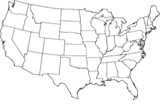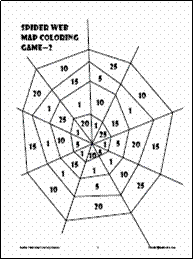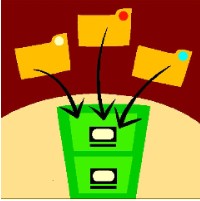June 2006

Featured Topic: Map Coloring
Introduce elementary students to the discrete math concept of map coloring. The basic concept is coloring a map using the fewest colors possible with these two rules:
- Regions that only touch at a vertex or point may be the same color.
- Regions that share a side (or portion of a side) must be different colors.

Students may use a blank map of the United States or a state map of counties to experiment with map coloring skills. It's often helpful for students to use pencil to code in colors before actually coloring so that they can easily rearrange colors, as necessary. The challenge is to color the map using the fewest number of colors. Can the USA map be colored using only 2 colors, or do you need 3 or 4 or 5 colors? Allow students to work on the task and consult classmates to compare notes and discuss the process they are using to minimize colors.
- Download
 Blank USA map.
Blank USA map.
-
 Map Coloring challenges students to evaluate a student's answer to a map coloring problem and explain whether they agree or disagree and why or why not.
Map Coloring challenges students to evaluate a student's answer to a map coloring problem and explain whether they agree or disagree and why or why not.
Four Color Theorem: In 1976, mathematicians used a super-computer to help prove that any map could be colored with four colors at most. Knowledge of this mathematical theory helps students work to color any map in 2-4 colors. Later, they will apply these same principles to graph theory.
- Read the history of the
 Four-Color Theorem on Wikipedia.
Four-Color Theorem on Wikipedia.
-
 Map Coloring: How Many Colors? also discusses the four-color theorem.
Map Coloring: How Many Colors? also discusses the four-color theorem.
Map Coloring for Students:
-
 The Young Map Colorer is an excellent resource for this topic. The site explains the topic and provides different maps for students to try as well as a collection of student-drawn maps.
The Young Map Colorer is an excellent resource for this topic. The site explains the topic and provides different maps for students to try as well as a collection of student-drawn maps.
-
 Maps Made by Kids showcases student work and provides great resources for a math center or enrichment topic. Challenge your students to create their own maps for coloring.
Maps Made by Kids showcases student work and provides great resources for a math center or enrichment topic. Challenge your students to create their own maps for coloring.
-
 Making a 2-colorable Map is a great project for students and they will be amazed that maps created using these directions are always colorable with only 2 colors.
Making a 2-colorable Map is a great project for students and they will be amazed that maps created using these directions are always colorable with only 2 colors.

Featured Game: Spider Web Map Coloring Games

Spider Web Map Coloring Game: this 2-4 player game challenges students to apply map coloring rules to win the most points by coloring in sections of the spider web on each dice toss. Students toss a special die (1-1-1-2-2-lose turn) to find out how many sections they may color in on that turn. The game ends when no player can color another section according to map coloring rules.
- Download
 Spider Web Map Coloring Games for game boards, directions and recording sheet for two different versions of the game. Gameboards may be inserted in sheet protectors for easy use in math centers. Students may use different color dry-erase markers or small rainbow cubes to mark their sections.
Spider Web Map Coloring Games for game boards, directions and recording sheet for two different versions of the game. Gameboards may be inserted in sheet protectors for easy use in math centers. Students may use different color dry-erase markers or small rainbow cubes to mark their sections.

Recent Additions to Mathwire.com
Check the New on Mathwire.com webpage to see what's new on the site this month.
Check the Recent Additions to Mathwire.com webpage to see the most recent additions to the site this month.
Enter your email address below to receive notifications when new content is added to Mathwire.
Featured Technology Links: Map Coloring
Students may use technology to draw and color maps. The Paint Map Coloring directions below are easy to follow and produce good results that students can print and compare.

- Directions for
 Paint Map Coloring provide step-by-step directions for opening the USA map and using Paint to color the map on the computer. These same directions will work for many of the other map coloring files found on internet sites, such as
Paint Map Coloring provide step-by-step directions for opening the USA map and using Paint to color the map on the computer. These same directions will work for many of the other map coloring files found on internet sites, such as  The Young Map Colorer. NOTE: Occasionally the Paint coloring will not work if the regions of the drawing are not truly closed and this is the case with many of the student-drawn maps.
The Young Map Colorer. NOTE: Occasionally the Paint coloring will not work if the regions of the drawing are not truly closed and this is the case with many of the student-drawn maps.
 How many colors of states are on a map of the US? provides background knowledge and a color explanation and solution.
How many colors of states are on a map of the US? provides background knowledge and a color explanation and solution.
- Students are challenged to color the map of South America using map coloring rules and the assigned costs of different colors. NOTE: Assigning color costs is a good twist to map-coloring problems.

Browse Other Activities on Mathwire.com
Visit this page for links to activities organized by math topics.
Browse Math Topics on Mathwire.comYou can click on the file icon to the left or access this link at the top right of any page on the website.
Recent Additions to Mathwire.com
Check the New on Mathwire.com webpage to see what's new on the site.
Mathwire Archives:

See Mathwire Archives for past issues of What's New on Mathwire.com and for past month's featured articles.
About Mathwire.com
Mathwire.com is designed to provide activities and appropriate worksheets for teachers to use in their classrooms. All activities and worksheets support the constructivist approach to learning mathematics and the NCTM Standards.
Activities: The activities on this site were developed by Terry Kawas and the teachers in districts where she has worked as a math consultant and coach or with students she has taught in college math-methods courses. The activities are classroom-tested by teachers and appropriate modifications have been made to reflect this field-testing. These activities are posted online in an effort to share quality activities and routines within the mathematics community.
Terms of Use: Teachers are welcome to download any of the activities for free use in their classrooms. No activities may be copied for use on other websites or included in commercial products without permission in writing from Terry Kawas, webmaster. Contact Terry Kawas